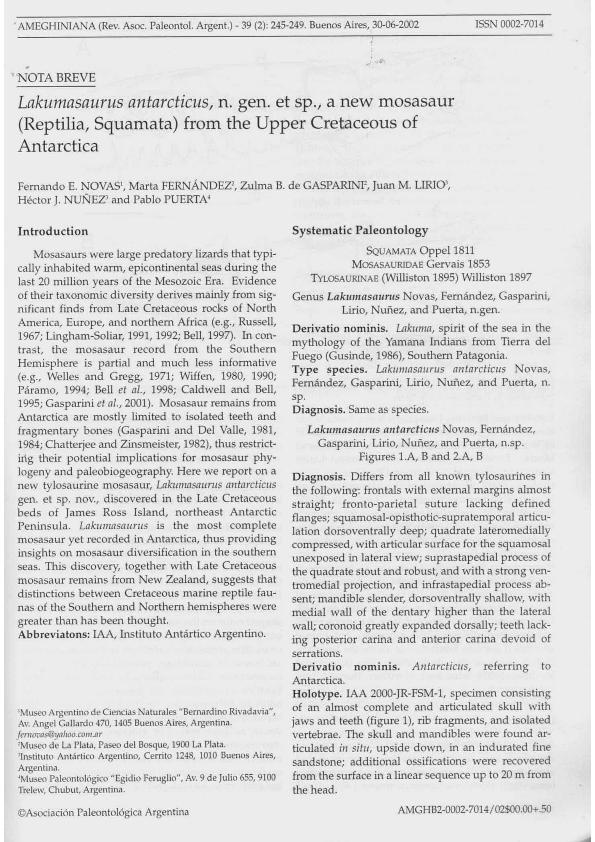Artículo
Lakumasaurus antarcticus, n. gen. et sp., a new mosasaur (Reptilia, Squamata) from the Upper Cretaceous of Antarctica
Novas, Fernando Emilio ; Fernández, Marta Susana
; Fernández, Marta Susana ; de Gasparini, Zulma B.; Lirio, Juan Manuel; Nuñez, Héctor J.; Puerta, Pablo
; de Gasparini, Zulma B.; Lirio, Juan Manuel; Nuñez, Héctor J.; Puerta, Pablo
 ; Fernández, Marta Susana
; Fernández, Marta Susana ; de Gasparini, Zulma B.; Lirio, Juan Manuel; Nuñez, Héctor J.; Puerta, Pablo
; de Gasparini, Zulma B.; Lirio, Juan Manuel; Nuñez, Héctor J.; Puerta, Pablo
Fecha de publicación:
06/2002
Editorial:
Asociación Paleontológica Argentina
Revista:
Ameghiniana
ISSN:
0002-7014
e-ISSN:
1851-8044
Idioma:
Inglés
Tipo de recurso:
Artículo publicado
Clasificación temática:
Resumen
Mosasaurs were large predatory lizards that typically inhabited warm, epicontinental seas during the last 20 million years of the Mesozoic Era. Evidence of their taxonomic diversity derives mainly from significant finds from Late Cretaceous rocks of North America, Europe, and northern Africa (e.g., Russell, 1967; Lingham-Soliar, 1991, 1992; Bell, 1997). In contrast, the mosasaur record from the Southern Hemisphere is partial and much less informative (e.g., Welles and Gregg, 1971; Wiffen, 1980, 1990; Páramo, 1994; Bell et al., 1998; Caldwell and Bell, 1995; Gasparini et al., 2001). Mosasaur remains from Antarctica are mostly limited to isolated teeth and fragmentary bones (Gasparini and Del Valle, 1981, 1984; Chatterjee and Zinsmeister, 1982), thus restricting their potential implications for mosasaur phylogeny and paleobiogeography. Here we report on a new tylosaurine mosasaur, Lakumasaurus antarcticus gen. et sp. nov., discovered in the Late Cretaceous beds of James Ross Island, northeast Antarctic Peninsula. Lakumasaurus is the most complete mosasaur yet recorded in Antarctica, thus providing insights on mosasaur diversification in the southern seas. This discovery, together with Late Cretaceous mosasaur remains from New Zealand, suggests that distinctions between Cretaceous marine reptile faunas of the Southern and Northern hemispheres were greater than has been thought.
Palabras clave:
Mosasaurs
,
Cretaceous
,
Antarctica
,
Weddellian fauna
Archivos asociados
Licencia
Identificadores
Colecciones
Articulos(MACNBR)
Articulos de MUSEO ARG.DE CS.NAT "BERNARDINO RIVADAVIA"
Articulos de MUSEO ARG.DE CS.NAT "BERNARDINO RIVADAVIA"
Citación
Novas, Fernando Emilio; Fernández, Marta Susana; de Gasparini, Zulma B.; Lirio, Juan Manuel; Nuñez, Héctor J.; et al.; Lakumasaurus antarcticus, n. gen. et sp., a new mosasaur (Reptilia, Squamata) from the Upper Cretaceous of Antarctica; Asociación Paleontológica Argentina; Ameghiniana; 39; 2; 6-2002; 245-249
Compartir



